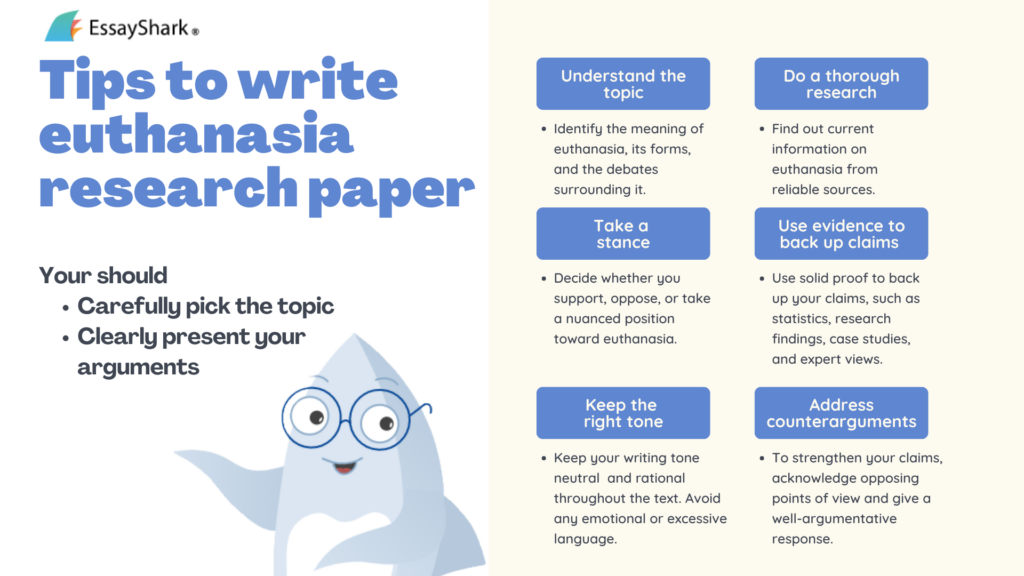Table of Contents
Ideas for euthanasia research papers

Euthanasia research paper writing tips
Writing your euthanasia research paper would be more difficult for you than a simple essay. Nevertheless, if you know the structure and know what to do in each part of your research, nothing is impossible! Start by choosing a specific angle—ethical, legal, medical, or social—and support it with well-researched evidence. If you’re unsure where to begin, reviewing dissertations topics in bioethics can help spark ideas.
So, first of all, after choosing your euthanasia paper topic (remember, that we’ve decided to choose euthanasia research paper), you have to search for all available information on the Internet and in libraries.
Secondly, you have to state your thesis. This is very important to make it right, so look for some thesis examples on the web. Or use our thesis statement generator for free.
Your next step is making an outline. Keep in mind that all the points should correlate to your research paper topic. Understanding how to write a diagnostic essay is also useful for outlining your initial thoughts before diving into detailed research.
Introduction – present your thesis here and explain, in brief, what the main goal of your euthanasia research paper is and why your potential readers should be interested in it.
In your body you have to give all the arguments you have to support your thesis. As it is not an essay, the number of arguments should be much bigger than in your essay on unemployment. If your argument references expert discussions, it’s essential to know how to write the title of a podcast in an essay to cite your sources correctly. Students from the best criminal justice schools may approach euthanasia from a legal standpoint, exploring its implications in law and public policy. Finish your body with the strongest argument you have prepared.
Conclusion – the same as usual: restate the thesis statement and give a short summary of your euthanasia research paper.
Your final task is to organize your notes, make corrections where it is needed and so on. After you do it, type the final draft and your euthanasia research paper is done! Note that even learning how to write an autobiography can offer perspective, especially when incorporating personal stories or case studies into your paper to humanize the issue.

Well, as you can see, it is absolutely possible to write an essay or research paper yourself. But we understand that sometimes you simply have no time for it, as you have to do other tasks too. That’s why we can offer you our help!
We are an academic writing company that has already helped a lot of students to succeed in studying. Our professional writers can do any written assignment of any difficulty and in any discipline. Let us help you write your essay or research paper! We guarantee the highest quality of your order for really affordable prices! Submit your application to EssayShark.com and be assured that we are the best custom writing service you will find.
Euthanasia research paper sample
Legalization of Euthanasia: Advantages and Disadvantages
The intention to deliberately accelerate the death of an incurable patient, even to stop his suffering, has never been unambiguous. The English philosopher Francis Bacon introduced the term euthanasia to denote light painless death, that is, calm and light death, without torment and suffering. Although the very idea of ??euthanasia originated a long time ago, from the time of Hippocrates to the present day, traditional medical ethics includes a ban: “To please no one will I prescribe a deadly drug, nor give advice which may cause his death.” Euthanasia is called any action aimed at putting an end to the life of a person, in pursuit of his/her will, and an uninterested person must do this.
It is worthy to note that the 39th World Medical Assembly adopted the Declaration on euthanasia, which states the following “Euthanasia, as an act of intentional deprivation of life of the patient at his/her request or the request of his/her relatives, is inadmissible, including the form of passive euthanasia. The doctor is obligated to ease the suffering of the dying by all available and legal methods.”
More and more people think that euthanasia is much more humane in some cases than life (Piccirilli Dorsey, Inc.). Nevertheless, it is necessary to find out whether people have the right to decide if someone needs to die or to live further. This question is of interest to both ordinary people and doctors. What is more, it is unlikely that humanity will come to a single denominator in this matter. That is why there are arguments for and against euthanasia.
To start with, the specific reasons for the legalization of euthanasia are as follows. Euthanasia makes it possible to fully exercise the human right to dispose of their lives, including making decisions on the termination of their own lives. Secondly, a person is recognized as the highest value, and consequently, her/his real well-being, the needs and the right to self-determination, the right to freedom, the right to respect for dignity, the right to dignity must be guaranteed and fully guaranteed (Strinic). Thirdly, euthanasia provides the implementation of one of the fundamental principles of law, the principle of humanism. Euthanasia is humane because it stops the suffering and torment of an incurably sick person. The state and society must recognize this right not for everyone, but for the sake of the small group of people who need it (Strinic). It is also worth noting the point of view of the European Court of Human Rights, which maintains a neutral position on this issue, recognizing the right of the States Parties to autonomy in settlement of euthanasia (Puppinck). Analyzing their decisions about euthanasia, it can be seen that, in most cases, the court did not take into account the material aspect of the cases, but resolved them on the basis of violations of the procedural form.
However, it should be recalled that, in fact, in all civilized countries, a murder of compassion persists in practice regardless of whether it is permitted by law or not. The literature indicates that 40% of all deaths of sick people occur as a result of medical decisions made by the physicians about the cessation of life either by refusing treatment or by drugs that accelerate its onset. Consequently, in countries where euthanasia is prohibited, where there is no legal protection against the misuse of euthanasia, the situation is worse. The legalization of euthanasia must go through some scientific, legislative filters that will establish rules, specific criteria and cases when such a right can be realized. The decriminalization of euthanasia is indicated by the Parliamentary Assembly of the Council of Europe (PACE) in the document “Questions and Answers on Euthanasia” of 10.09.2003, will control this process and restrict it to a clear framework of the law. Only controlled procedures and clear rules for the use of euthanasia will end the arbitrary system existing in many European countries (Council of Europe).
Jonathan Van Maren cites twenty arguments against euthanasia (Maren). First of all, it is believed that suicide with assistance or euthanasia is death with dignity because it occurs quickly. It turns out that those who do not die quickly die without dignity. Secondly, suicide with the help destroys the appointment of medical institutions: to treat patients, save lives and reduce pain. Adding the killing of patients to the list of “medical services” will become an encroachment on the very essence of medicine. Thirdly, suicide for the help makes people who want to use this “service,” second-class citizens (Maren). If a person who does not have depression cannot claim to be in a position to die. As for a person with depression, the state actually confirms that life with depression is less valuable. Fourthly, euthanasia requires that the state and medical institutions determine whether a person should live. As a result, people with disabilities become second-class people, because their lives are less valuable than people without disabilities. Parents of disabled children in Belgium are advised to expose children to euthanasia. Euthanasia, translated from the Greek as good death is placed in dependence on the eugenics, in Greek, which means good birth (Maren). Just as abortion justifies the killing of unborn children with Down syndrome and other abnormalities, euthanasia is used to kill already-born people, but less sophisticated than others. Fifthly, suicide with assistance erases borders. If someone has a mental illness and has the right to use a suicide hotline, which is funded by the government, there is a stumbling block what doctors should do. The question is to deny a man from death or not. Then, it ups in the mind whether such pressure will be a violation of the new rights of citizens in a state where the government permits murder or not. After all, once they decided that the woman had the right to abort, people immediately began to blame those who tried to discourage women from abortion, in violation of their rights.
What is more, suicide for assisting makes suicidal people much more vulnerable, since, having legalized the possibility for a person to kill him-/herself, the government has confirmed that these people should not live? Seventhly, suicide for assistance gives rise to a new definition of the term cure, which now affects deadly poison, issued by a physician with a clear intention to kill a person (Maren). Suicide for assistance creates a new, fictitious right, the right to death. It undermines the right to life, which can not be abandoned, even voluntarily. The right to death is a legal absurdity. Providing the state and courts with the right to legalize murder is an extremely dangerous step that has far-reaching consequences. In the Netherlands, many people are victims of forced euthanasia (Maren).
Next to the facts, to provide medical professionals with the legal right to kill, even in limited circumstances, are unreasonable and dangerous. Using this right, people can hide medical negligence or ill-treatment. Such precedents have already been in European countries, where euthanasia is legalized. The eleventh against proclaims that children can push their parents so that they take advantage of the new service. Such cases were recorded in the United States and Europe. When people live a long time and spend their savings on themselves, it is easy to predict the reaction of a selfish child who sees her/his dying heritage. The twelfth fact explains that those who advocate the legalization of euthanasia ignore the fact that people may be under pressure and use this service for various reasons. For example, the legalization of euthanasia for children in Belgium ignores the fact that children can be subjected to pressure in opposition to their interests (Maren). As a thirteenth against, there is a point that there is little discussion about how the final stage of euthanasia should be carried out. So-called precautionary measures have been illusory or ineffective in all jurisdictions where euthanasia is legalized. It is known that many feel great relief if their suicide attempt was unsuccessful, but anyone cannot question the victims of euthanasia or regret their decision.
Moreover, suicide for assistance is based on a secular principle. After death, nothing is possible; suicide does not affect anything. It is very arrogant. If, as Christians believe and practically all of the Western civilization up until recently), life after death exists, suicide is an act with enormous moral consequences. Also, suicide for assistance as a moral issue has never been discussed, even on the periphery. Those who seek to legalize euthanasia seem to have simply taken the Axiom’s view that suicide for assistance is a right without making any attempt to formulate a clear philosophy to illustrate why this is so. The sixteenth against proclaims that abuse of euthanasia occurs wherever it is legal. For example, judges in the Netherlands have allowed some families to subject their elderly parents with dementia to euthanasia, despite the fact that the parents themselves have never asked for euthanasia and there was no weighty evidence that they wanted to die. The president of the Exit branch in German-speaking Switzerland Saskia Fry said that “opponents of organized suicide believe that older people are not able to make decisions” (Maren).
Nevertheless, the elderly person reflects and decides independently. What is more, their close people and relatives are trying to resist the choice of a person to commit suicide. It is worthy to note that older people are much better informed, more autonomous and self-confident than before and called for not underestimating the experience and qualifications of those who help to get out of life. Also, in countries, where legalization of euthanasia exists, the prices for this service increase. In Belgium and the Netherlands every year, a considerable number of people die as a result of euthanasia.
The eighteenth against implies specialists in ethics insist that forced euthanasia or rather a murder for children should be legalized. In the Netherlands, this has already happened (Jotkowitz). What is more, suicide for help and euthanasia devalue human life? After all, medical institutions are killing a suffering person as if a domestic animal was slaughtering.
The last but not the least is where the suicide with assistance is legalized, activists of euthanasia push this service into all possible spheres. Their words about some kind of precautionary measures and limited circumstances are an outright lie. The ultimate goal is to provide euthanasia upon the request and without any kind of apology.
It can be said that the only minus of euthanasia is its gloomy coloring in society. It always sprawls on religious dogmas, which can not but offend the feelings of unbelievers who are hungry for it day by day. Also, people are gently saying strange and useless analogies to the past with the naturalness of death and anguish, utterances like one must live (Piccirilli Dorsey, Inc.). The public was obsessed with the cult of life as an absolute good and lost any culture of death. Suicide is not savagery. Wildness is when a man of the 21st century dies as the last beast because of someone’s prejudices. This is nothing but a public opinion that still cannot support euthanasia with even half of its votes. To sum up, everything that was mentioned above, one should admit that the problem of euthanasia requires criminal legal regulation. As the solution to this, the fate of many hopelessly sick people, who in recent years have been in hospitals, whose physical condition is diagnosed as an intermediate one, between life and death, and the mental one, is helplessness, a state of deep despair.
Works Cited
Council of Europe, Parliamentary Assembly, Social, Health and Family Affairs Committee. “Assistance to Patients at End of Life.” Liberal, Democratic and Reformers’ Group, by Dick Marty, 9 Feb. 2005, www.dgpalliativmedizin.de/images/stories/pdf/50209%20PA%20Report%20Marty%20(Doc%2010455).pdf.
Kuhse, Helga. “Euthanasia Fact Sheet.” Bioethics News, vol. 11(4), 4 July 1992, www.worldrtd.net/euthanasia-fact-sheet.
Jotkowitz, Alan. “The Groningen Protocol: Another Perspective.” Journal of Medical Ethics, vol. 32, no. 3, 2006, pp. 157-158. NCBI, doi:10.1136/jme.2005.012476.
Strinic, Visnja. “Arguments in Support and Against Euthanasia.” British Journal of Medicine and Medical Research, vol. 9, no. 7, 2015, pp. 1-12. Sciencedomain International, doi:10.9734/BJMMR/2015/19151.
Puppinck, Grégor, and Claire de La Hougue. “The Right to Assisted Suicide in the Case Law of the European Court of Human Rights.” The International Journal of Human Rights, 18:7-8, 2014, pp. 735-755., doi: 10.1080/13642987.2014.926891.
Maren, Jonathon. “20 Reasons Why Euthanasia Corrupts Everything It Touches, and Must Be Opposed.” LifeSiteNews, LifeSite, 9 June 2016, www.lifesitenews.com/blogs/20-reasons-why-euthanasia-corrupts-everything-it-touches-and-must-be-oppose.









